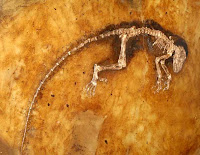 47-million-year-old primate could be human ancestor
47-million-year-old primate could be human ancestor Scientists unveiled a 47-million-year-old primate
Scientists unveiled a 47-million-year-old primateDr. Jorn Hurum of the University of Oslo in Norway led the team of scientists who studied the small monkeylike female. Hurum nicknamed her "Ida," after his own 6-year-old daughter.
Hurum's team thinks she may be a distant ancestor of monkeys, apes, and humans. That means that studying Ida could tell scientists more about how modern human beings developed.
Fossil "Ida" was found in an area
of Germany that is rich with ancient
fossils, called the Messel Pit. (Map:
Jim McMahon.)
Ida was found in an area of Germany that is rich with ancient fossils, called the Messel Pit.
Ida is so well-preserved that impressions of her fur are still clear. Scientists also found evidence of food where her stomach would have been. The animal's last meal was fruit and leaves. fossil at the American Museum of Natural History in New York City on Tuesday. Scientists say it is "the most complete primate fossil ever found."
Hurum's team says Ida has many humanlike characteristics. She has opposable thumbs and fingernails instead of claws. X-rays show both baby and adult teeth. She had eyes that faced forward, which allowed her to see in three-dimensions and judge distance.
Scientists believe Ida was about 9 months old when she died.
Ida's debut has sparked a lot of debate among scientists. They have different opinions about how closely linked she is to the prehuman animals that evolved after her.
One thing scientists do agree on is the quality of the fossil primate.
"There's certainly a lot more information about this individual than probably any other fossil primate that's ever been recovered," said primate expert Dr. John Fleagle. (Fleagle is not a part of the research team that has been studying Ida.)
Hurum says there is much more to learn from the 47-million-year-old fossil.
"She tells so many stories," Hurum told reporters on Tuesday. "We have just started the research on this fabulous specimen."
Since her big debut on Tuesday, Ida has returned to her permanent home at the University of Oslo Natural History Museum in Norway. But a plaster version of the fossil has become a part of the "Extreme Mammals" exhibit at the American Museum of Natural History in New York City.
The History Channel will air a documentary about Ida called The Link, on Monday, May 25. You can learn more about Ida online at http://www.history.com/thelink.
No comments:
Post a Comment